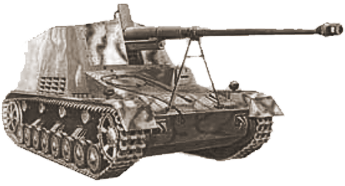Summer Stalemate in Normandy
Following D-Day the Allied campaign to liberate France is often regarded as anticlimactic. What is often forgotten however, is that July of 1944 proved an anxious time for the Allied leadership. By July of 1944, enormous political pressure was mounting within the western democracies as the Allied military machine had bogged down in Normandy. Real fears regarding a return to the horrors of World War One style trench warfare swept through the Allied command. By July 1, 1944, the Allied beachhead was at only one-fifth the size Overlord's planners had envisioned it would be nearly one month following D-Day. In addition, Allied strategic planners increasingly worried the Germans may actually commit their reserves to Normandy. Most distressingly for Eisenhower, if the Germans did move the Fifteenth Army's striking power from the Calais region to Normandy then Rommel could pull his panzer divisions from the frontlines and refit the spent panzers for a massive counterattack.
The Fifteenth Army's disposition carried enormous implications for the Allies. If Hitler and OKW created the preconditions for creating an armored reserve behind German lines, by releasing the field capable infantry divisions in Calais, the Germans might have indefinitely tied down the Allies in Normandy. As evidenced by the limited port capacity at Cherbourg, the feared artificial cap on the Allied army's size in France created by the tyranny of logistics would allow the Germans to hold the Allies in place until the winter. If that happened the winter weather would partially vitiate Allied advantages in air power. In addition, the winter weather would have likely regularly put out of action the artificial Mulberry harbors off the Normandy beaches. In July of 1944 there were thus real and immediate time pressures on Eisenhower and his staff. In short Eisenhower had to break the stalemate.
Furthermore, the first weeks in July had proved anything but comforting to Allied commanders as they witnessed the first substantial German infantry redeployments to the German 7th Army defending Normandy. Rommel was even able to withdraw several battered panzer divisions for temporary respites, as the rate of advance in the American sector of the beachhead slowed to little more than a crawl. The VIII and VII Corps from the American First Army, though capably led by Middleton and Collins respectively, still only won meager advances in July's first weeks. Middleton's VIII Corps advanced a mere 12,000 yards from July 3-July 14th in an offensive attaining nowhere near its objectives. The Americans had sought to move south from the Cotentin's west coast, with lofty goals of forging a jumping off point for the larger planned breakout near Coutances.
St. Lo eventually fell to the Americans, but the offensive was instrumental in bringing to the forefront Allied fears regarding renewed World War One style attritional battles. Five American divisions sustained 11,000 casualties during the two-week's it took to secure the city. Meanwhile, the British faced a veritable defensive wall near Caen; draining British manpower to crisis levels. The British industrial and military effort had neared its breaking point. Thus, when General Omar Bradley set about planning how to break through the German defenses just south of St. Lo, the last remaining barrier between the Allies and the relatively open tank country in Central France, he would leave almost nothing to chance.
by Steven Douglas Mercatante



Post new comment